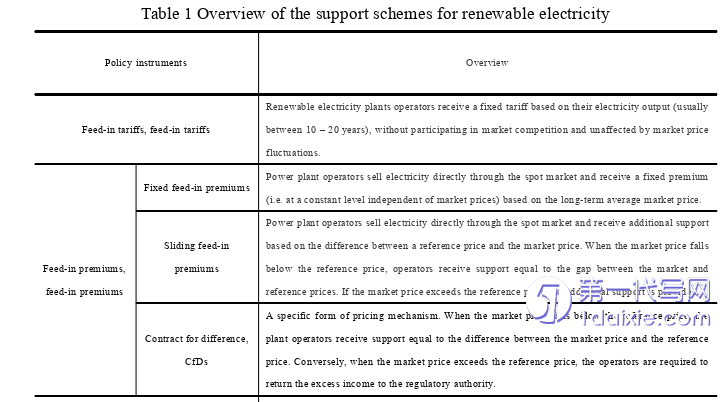本文是一篇英语论文,本研究结果表明,招标政策是欧盟各成员国中应用最广泛的可再生能源电力支持政策;在单个政策工具碳减排效应分析中,绿色电力证书交易、招标和上网电价溢价三项市场型政策工具的温室气体减排效应显著;政策工具组合碳减排效应分析显示,实现减排目标的有效政策组合有多种,且这些组合均为同时包括市场型和政府型政策工具的组合,不存在实现减排目标的必要的政策工具。
CHAPTER ONEINTRODUCTION
1.1 Background and context
Climate change is one of the most urgent issues for the international community,andglobal climate governance represents a collaborative effort to safeguard global ecologicalsecurity and the shared interests of humanity.In 2015,at the Paris Climate ChangeConference,the 196 parties to the United Nations Framework Convention on Climate Change(UNFCCC)reached a consensus to adopt the Paris Agreement.This agreement establishedlong-term temperature targets,aiming to limit the increase in global average temperature towell below 2℃above pre-industrial levels,with an aspiration to limit the rise to 1.5℃(United Nations Framework Convention on Climate Change,2015).Furthermore,it called forachieving global peaking of greenhouse gas(GHG)emissions as soon as possible,with thegoal of reaching net-zero emissions in the second half of this century.According to theInternational Energy Agency(IEA),the energy-related emissions currently account forapproximately three-quarters of greenhouse gas emissions and is crucial for mitigating thesevere impacts of climate change.The Net-Zero Emissions by 2050 Scenario(NZE)outlinesan unprecedented global energy system transformation.Central to achieving net-zeroemissions by 2050 is the decarbonization of the electricity sector,which is projected to be thefirst sector to reach net-zero emissions(International Energy Agency,2021).As theelectricity sector becomes cleaner,electrification of the three main end-use sectors,includingtransport,building and industry,emerges as a crucial tool for reducing emissions.
1.2 Research questions and objectives
RQ1:The policy instruments adopted by European Union member states to promoteelectricity from renewable energy sources.
RQ2:The effectiveness of individual policy instruments in reducing greenhouse gasemissions in the EU.
RQ3:The effectiveness of different policy instrument combinations and how they worktogether to achieve emission reduction targets.Identifying the sufficient and necessaryconditions for determining which policy instruments are essential to achieving emissionreduction targets.
This study aims to provide insights and policy implications for the development ofrenewable energy in China’s electricity sector based on the results of an empirical analysis ofthe European Union.
CHAPTER TWOLITERATURE REVIEW
2.1 Explanation and classification of policy instruments
Fossil fuel-based electricity generation is a major source to greenhouse gas(GHG)emissions,which drive climate change.Replacing fossil fuels with renewable energy sourcesis essential to achieving substantial reductions in GHG emissions and transitioning toward asustainable energy system.However,markets frequently fail to internalize the external costsof fossil fuel consumption,such as environmental degradation and adverse health impacts.Renewable energy technologies face significant barriers due to their high initial costs,makingthem less competitive in the energy market.This results in market failures,where the prices offossil fuels do not reflect their true societal costs,thereby distorting resource allocation andhindering the transition to renewable energy sources.The European Union has sought tocorrect market failures through policy intervention,introducing support schemes to promoterenewable energy development(European Commission,2013).
The Renewable Energy Directive(Directive 2001/77/EC)provided a legal framework forEU Member States to support renewable electricity production,encouraging and regulatingthe adoption of support schemes at the legislative level(European Union,2001).In 2008,theEuropean Commission reviewed Member States’support schemes for supporting renewableelectricity,detailing instruments such as feed-in tariffs,feed-in premiums,tradable greencertificates,tendering,tax incentives(e.g.,exemptions or reductions),investment subsidies,and loans in the report(European Commission,2008).

2.2 The background and history of NECPs
In December 2015,the European Commission proposed the establishment of theEuropean Energy Union,envisioning the integration and coordination of energy policiesacross EU member states to promote the development of a more cohesive,secure,andsustainable energy system.Subsequently,the EU introduced the Clean Energy for AllEuropeans package,aimed at readjusting its energy policy framework to facilitate thetransition from traditional fossil fuels to cleaner,more sustainable energy sources,therebyfulfilling its commitment to achieving carbon neutrality by 2050.As part of the Clean Energyfor All Europeans package,the Regulation on the Governance of the Energy Union andClimate Action(EU)2018/1999 mandates that EU member states draft ten-year NationalEnergy and Climate Plans(NECPs),to be implemented from 2021 through 2050.In theirNECPs,member states are required to set national targets across five dimensions of theEnergy Union:decarbonization and renewable energy,energy efficiency,energy security,energy markets,and research,innovation,and competitiveness,and to develop currentexisting and planned policies and measures at the national level,including those for eachsector and technology,with special attention to renewable energy support schemes in theelectricity,heating and cooling and transport sectors.
CHAPTER THREE METHODOLOGY.............................13
3.1 Text content analysis............................13
3.2 Two-way fixed effect model..............................13
3.3 QCA....................................13
CHAPTER FOUR ENERGY POLICIES IN THE ELECTRICITY SECTOR OF EU STATES154.1 Data sources..........................15
4.2 Process for policy extraction....................15
4.3 Interpretation of policy texts and identification of policy instruments............16
CHAPTER FIVE EFFECTIVENESS OF EU ENERGY POLICIES IN THE ELECTRICITYSECTOR...................26
5.1 Analysis of policy effectiveness based on regression model................26
5.1.1 Data collection..........................26
5.1.2 Variables............................27
CHAPTER SEVENINSIGHTS INTO THE ESTABLISHMENT OF CHINA’S ENERGY POLICY SYSTEM
7.1 Overview of renewable electricity policy instruments in China
According to the IEA,China is currently the world’s largest carbon emitter,withemissions from electricity and heat production accounting for 57%of its total emissions.Inrecent years,China has initiated measures to promote renewable energy in the electricitysector.However,coal remains the dominant source,constituting 62%of total electricitygeneration(International Energy Agency,2022).Therefore,increasing the proportion ofrenewable energy in the electricity sector is essential for China to achieve meaningfulreductions in greenhouse gas emissions.Studies show that renewable energy development hasa substantial mitigating effect on carbon emissions.As renewable energy penetration rises inprovincial power systems,emissions from the electricity sector decrease accordingly.Greaterrenewable energy shares at the provincial level contribute to emission reductions,while alsolowering both carbon intensity and per capita emissions(Wang et al.,2023).Notably,withoutemission reductions in the electricity sector,electrifying the transportation sector alone will beinsufficient for significant carbon reduction,underscoring the critical need for an energytransition within China’s power sector(Li et al.,2024).
Since 2011,China has implemented policy measures aimed at promoting energytransition within the electricity sector,beginning with the introduction of feed-in tariffs(Tu etal.,2020,pp.95-102;Zhang et al.,2022).The IEA in its Renewables 2024 report highlightsthat feed-in tariffs is the main pillar supporting renewable electricity development,accountingfor approximately 90%of China’s renewable electricity generation growth.Market-basedpolicy instrument,which do not depend on government-set prices,account for only 10%ofthe growth in renewable electricity in China(International Energy Agency,2024).While mostof China’s renewable energy growth is still driven by government-set pricing and fixed tariffs,the role of market mechanisms is expected to increase in the future.

CHAPTER EIGHTCONCLUSIONS
Global greenhouse gas emissions continue to rise,temperature records are consistentlybeing broken,and the impacts of climate change are intensifying.The United NationsEnvironment Programme’s 2024 Emissions Gap Report warns that without strongercommitments to carbon reduction,global temperatures will far exceed the targets set by theParis Agreement(United Nations Environment Programme,2024).Addressing climate changehas been prioritized in national governance.China has continuously strengthened itsNationally Determined Contributions(NDCs)and ramped up efforts to reduce carbonintensity,enhancing its climate action ambitions to the fullest extent.Since 2011,China hasimplemented measures aimed at promoting energy transition within the electricity sector,suchas feed-in tariffs and tradable green certificates.However,tradable green certificates schemeis still in the early stages,and the overall policy framework remains underdeveloped.Moreover,the subsidy model of feed-in tariffs has imposed a financial burden on thegovernment,highlighting the urgent need for new support instruments to promote thedevelopment of renewable electricity.The European Union began its energy transition earlierand has accumulated valuable experience and data that can provide an analytical foundationfor addressing these issues.This study analyzes the policy instruments and GHG emissionreduction targets in EU member states,offering insights and references for the construction ofa renewable energy policy framework in China.
reference(omitted)
